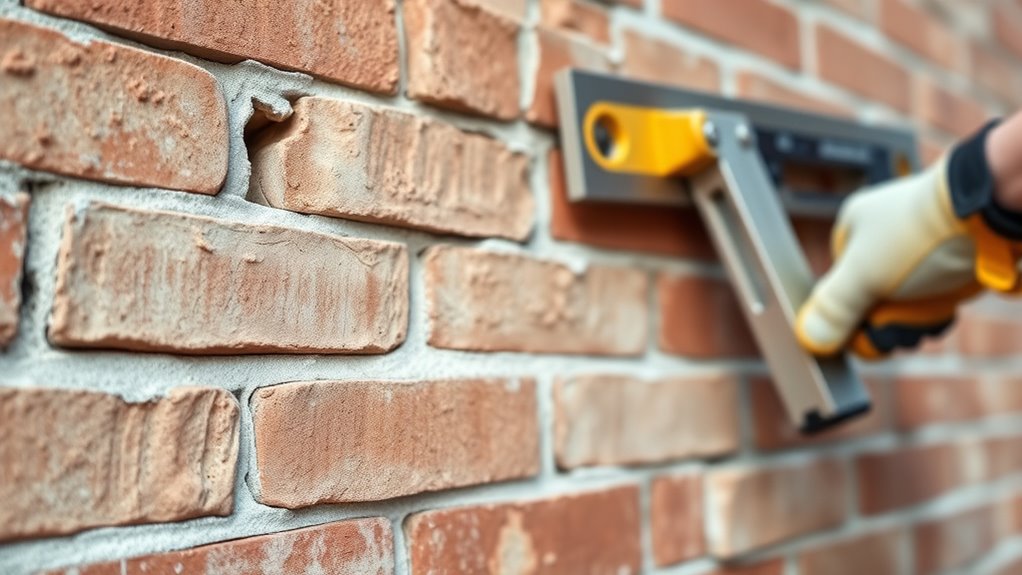To avoid common construction mistakes, focus on thorough planning and clear design, involving experienced professionals to prevent costly errors. Keep a realistic budget with contingency funds, and stay on top of permits and regulatory requirements to avert delays or legal issues. Maintain open communication and supervise closely to ensure safety and quality. If you want to learn how to navigate these pitfalls effectively, there’s more to uncover below.
Key Takeaways
- Avoid poor planning and design flaws by involving experienced professionals and considering site conditions and building codes.
- Establish a realistic budget with contingency funds to prevent cost overruns and track expenses regularly.
- Obtain all necessary permits and ensure compliance with local building regulations to prevent delays and legal issues.
- Maintain clear communication and supervision to minimize misunderstandings, errors, and safety hazards.
- Consider future expansion, site-specific conditions, and updated building codes during planning to prevent costly modifications.
Poor Planning and Design Flaws
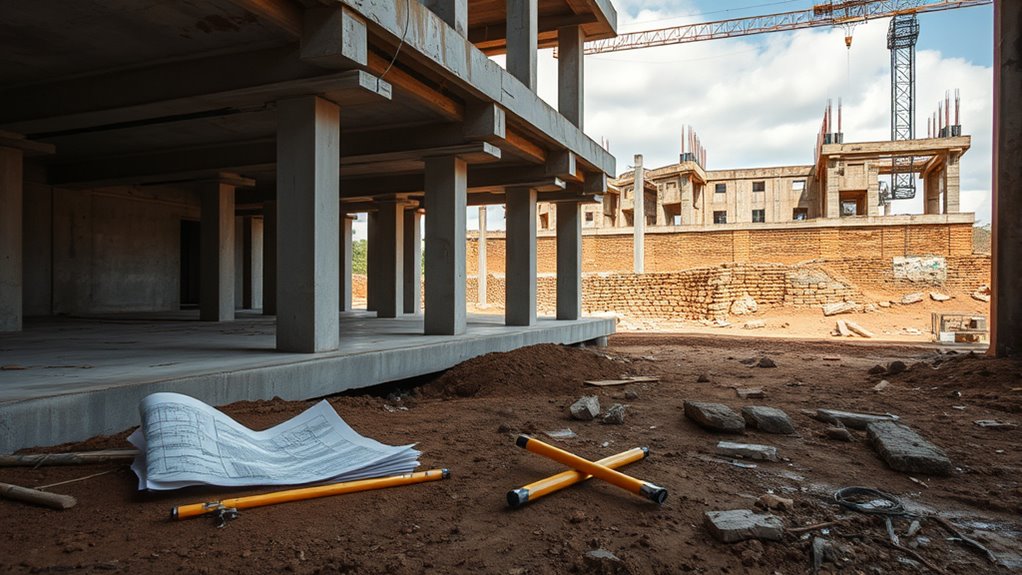
Poor planning and design flaws are among the most common mistakes that can derail a construction project. When you skip thorough planning, you risk overlooking critical details that could cause delays or costly changes later. Inadequate design can lead to structural issues, poor functionality, or failure to meet safety standards. It’s essential to involve experienced architects and engineers from the start, ensuring your plans are realistic and well-coordinated. Failing to contemplate site conditions, building codes, or future expansion needs can create major obstacles down the line. Always review designs carefully and incorporate feedback from professionals. Proper planning and sound design are the foundation of a successful project, helping you avoid costly revisions and ensuring the final structure meets your expectations. Additionally, overlooking building code requirements during the planning phase can result in legal complications or the need for significant modifications.
Inadequate Budgeting and Cost Overruns
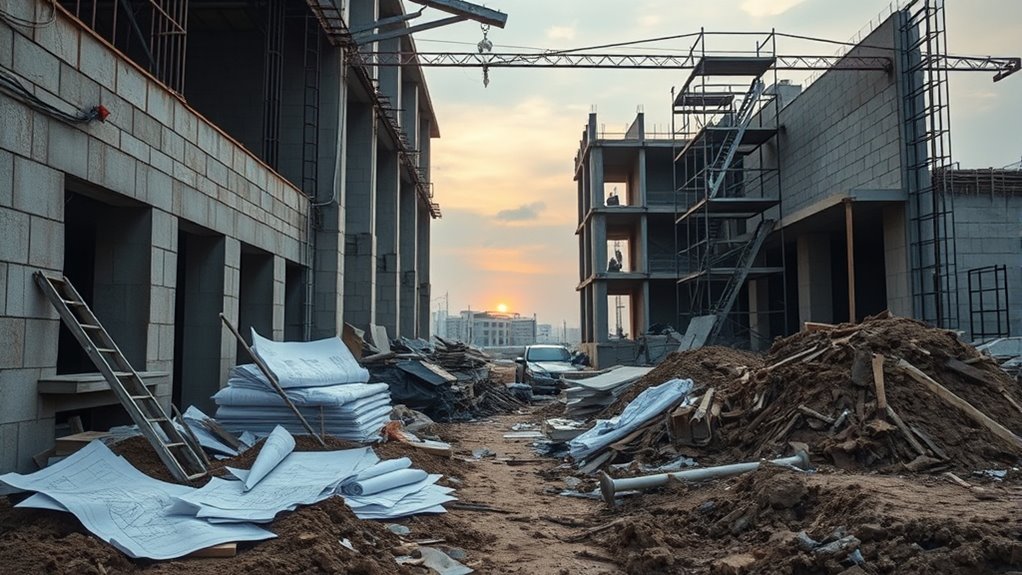
Inadequate budgeting often leads to unexpected expenses and project delays, jeopardizing the overall success of your construction project. Without a realistic budget, unforeseen costs can quickly spiral out of control, causing delays and compromising quality. To avoid this, thoroughly estimate costs upfront, including contingency funds for surprises. Keep detailed records and regularly review expenses to stay on track. Remember, underestimating expenses is a common mistake that can derail your project. Additionally, neglecting to account for cost fluctuations can result in significant budget overruns.
Neglecting Permits and Regulatory Compliance
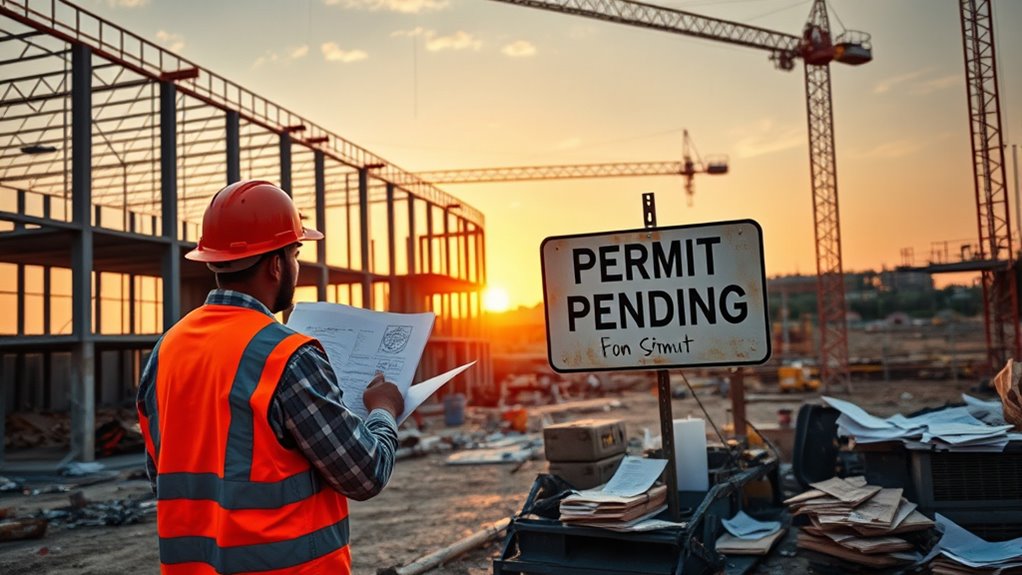
Neglecting permits and regulatory compliance can lead to serious delays, fines, and legal issues that threaten your project’s success. Ignoring these requirements risks halting construction and facing costly penalties. Without the proper permits, your project might not meet safety standards or zoning laws, which can cause inspections failures or forced stops. You could also face legal action or lawsuits if regulations are violated. To avoid these pitfalls, make certain you:
- Obtain all necessary permits before starting work
- Stay updated on local building codes and regulations
- Keep thorough documentation of approvals and inspections
- Consult with professionals familiar with local laws
- Conduct thorough risk assessments for compliance to identify potential legal vulnerabilities before beginning construction.
Poor Communication and Supervision
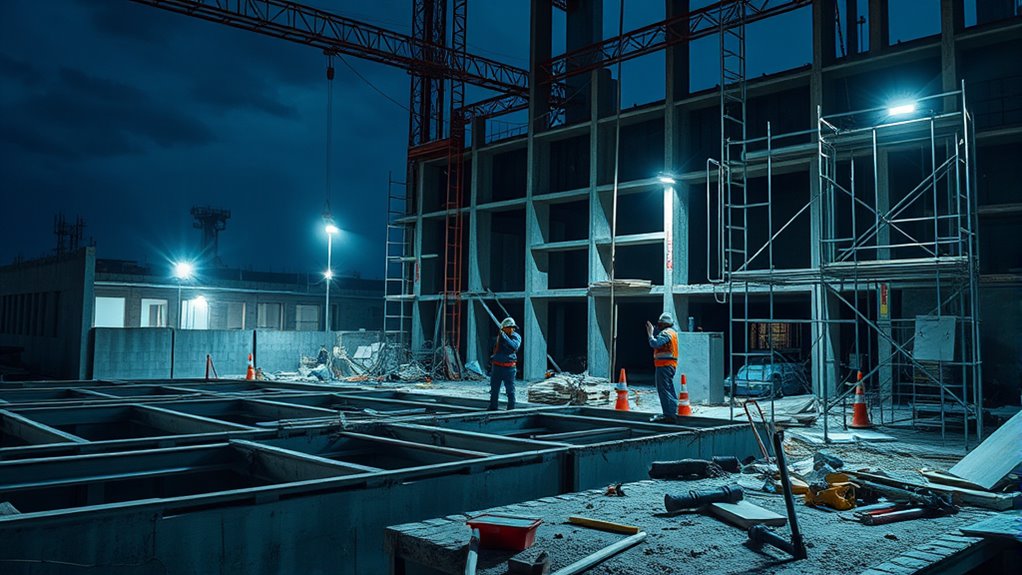
Effective communication and supervision are essential for keeping a construction project on track, but lapses in these areas often lead to costly mistakes. When you fail to clearly convey instructions or neglect to monitor progress closely, misunderstandings arise, causing delays and rework. Supervisors must stay engaged, ensuring workers understand their tasks and safety protocols. Poor oversight can result in substandard work, safety hazards, or overlooked details, all of which inflate costs and extend deadlines. To avoid these issues, maintain open lines of communication, hold regular meetings, and actively oversee every phase of construction. Doing so helps catch problems early, keeps everyone aligned, and ensures the project runs smoothly from start to finish. Incorporating effective supervision practices can significantly reduce errors and improve overall project outcomes.
Frequently Asked Questions
How Can I Select the Right Construction Team?
To select the right construction team, start by researching their experience and checking reviews from past clients. Make certain they’re licensed and insured, and ask for references to verify their work quality. Meet with potential teams to discuss your project and gauge their communication skills. Trust your instincts; choose a team that listens well, offers clear timelines, and shows professionalism. Doing this helps ensure your project runs smoothly and meets your expectations.
What Are the Signs of Poor Project Management?
If your project falls behind schedule, goes over budget, or experiences frequent miscommunications, these are clear signs of poor project management. You might also notice a lack of clear plans, inconsistent quality, or unaddressed issues piling up. Don’t assume delays are normal; instead, tackle these problems early. Staying proactive and demanding transparency helps keep your project on track and ensures better management throughout the process.
How Do Weather Conditions Impact Construction Timelines?
Weather conditions can considerably delay your construction timelines. Heavy rain, snow, or storms can halt work, cause safety hazards, and damage materials. Extreme heat may slow progress and affect worker productivity. You should plan for weather-related setbacks by building buffer time into your schedule, monitoring forecasts closely, and using weather-resistant materials. Staying flexible and prepared helps you minimize delays and keep your project on track despite unpredictable weather.
What Safety Protocols Should Be Prioritized During Construction?
Imagine safety as your foundation, sturdy and unwavering. You should prioritize wearing personal protective equipment, maintaining clear communication, and enforcing strict site protocols. Regular safety training and hazard assessments keep risks in check, creating a safe environment amid the chaos of construction. By staying vigilant and proactive, you protect yourself and your team, ensuring the project progresses smoothly without preventable accidents. Safety isn’t just a rule; it’s your top priority.
How Can Technology Improve Construction Project Accuracy?
You can enhance construction project accuracy by leveraging technology like Building Information Modeling (BIM), which provides detailed 3D models for precise planning. Using drones for site surveys guarantees accurate measurements and progress tracking. Implementing project management software helps keep schedules and budgets on track, reducing errors. Additionally, utilizing laser scanning ensures detailed site data, minimizing discrepancies. Embracing these tools makes your project more accurate, efficient, and less prone to costly mistakes.
Conclusion
If you think you’ve covered all the bases, think again. Overlooking these common mistakes can quietly unravel your project when you least expect it. Are you truly prepared to handle surprises that might arise from poor planning or regulatory slip-ups? The key to a successful build isn’t just avoiding errors—it’s staying vigilant. Because in construction, what you don’t see can be the very thing that costs you the most. Are you ready to face what’s next?
